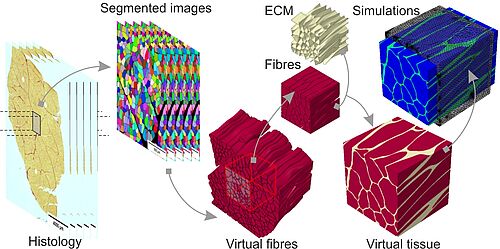
Basic Funding

In this project, three-dimensional (3D) finite element models are generated from a series of histological sections of porcine skeletal muscle tissue. Image registration is performed on the stained sections by affinely aligning them using auxiliary markers, followed by image segmentation to determine the muscle fibres and extracellular matrix in each section, paying particular attention to fibre continuity through the stack.
Using this information, 3D virtual tissue samples are reconstructed, discretised and associated with appropriate non-linear elastic anisotropic material models. While the gross anatomy is obtained directly from the images, the local directions of anisotropy are determined using an analogy to steady-state diffusion.
The influence of the number of histological sections considered for reconstruction on the numerically simulated mechanical response of the virtual tissue samples is then investigated. The results show that muscle tissue is quite heterogeneous along the fascicles and that transverse isotropy is insufficient to describe its material symmetry on the typical length scale of a fascicle. Numerical simulations of different loading cases suggest that ignoring the undulations of the fibres and their non-uniform cross-sections has only a moderate effect on the passive response of the tissue in tensile and compressive modes, but can become critical when predicting the response to generic loading and activation.
Moreover, based on decellularisation of fresh tissue samples, a novel set of experimental data on the direction-dependent mechanical properties of collagenous ECM was established. Together with existing information on the material properties of single muscle fibres, the combination of these techniques allows computing predictions of the composite tissue response.
To this end, an inverse finite element procedure is proposed in the present project to calibrate a constitutive model of the extracellular matrix, and supplementary biaxial tensile tests on fresh and decellularised tissues are performed for model validation.
The results of this rigorously predictive and thus unforgiving strategy suggest that the prediction of the tissue response from the individual characteristics of muscle cells and decellularised tissue is only possible within clear limits. While orders of magnitude are well matched, and the qualitative behaviour in a wide range of load cases is largely captured, the existing deviations point at potentially missing components of the model and highlight the incomplete experimental information in bottom-up multiscale approaches to model skeletal muscle tissue.
